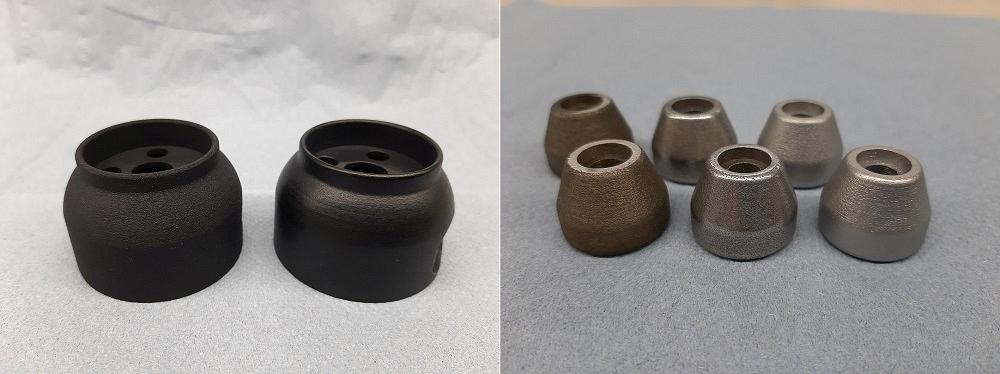- FMA
- The Fabricator
- FABTECH
- Canadian Metalworking
Our Publications
Categories
- Additive Manufacturing
- Aluminum Welding
- Arc Welding
- Assembly and Joining
- Automation and Robotics
- Bending and Forming
- Consumables
- Cutting and Weld Prep
- Electric Vehicles
- En Español
- Finishing
- Hydroforming
- Laser Cutting
- Laser Welding
- Machining
- Manufacturing Software
- Materials Handling
- Metals/Materials
- Oxyfuel Cutting
- Plasma Cutting
- Power Tools
- Punching and Other Holemaking
- Roll Forming
- Safety
- Sawing
- Shearing
- Shop Management
- Testing and Measuring
- Tube and Pipe Fabrication
- Tube and Pipe Production
- Waterjet Cutting
Industry Directory
Webcasts
Podcasts
FAB 40
Advertise
Subscribe
Account Login
Search
Automated mass finishing delivers quality, repeatable results on 3D-printed components
- December 8, 2022
- News Release
- Additive Manufacturing
Situation
Founded in 1990, the 40-employee metal processing job shop Klaus Stöcker offers a variety of machining services, including turning, milling, sinking and wire EDM, face and circular grinding, assembly, and measuring. Serving customers in the automotive, pharmaceutical, food, and machinery building industries, the company fabricates its own tooling, fixtures, gauges, and special machinery.
In 2016, Stöcker began offering 3D-printed plastic and metal parts and since then has installed 16 printers. Using the fused filament fabrication (FFF) and selective laser sintering (SLS) printing methods, the company manufactures components made from different types of plastic, including PA 6 and PA 12, but also materials reinforced with glass, carbon, and Kevlar fiber.
Stereolithography is primarily used for printing optical components with different technical characteristics and in different colors. Selective laser melting (SLM) and atomic diffusion additive manufacturing (ADAM) are used to make metal components from aluminum alloys, different types of stainless steel, and various tool steels.
Stöcker quickly realized it can only be successful if it offers services within the entire process chain, not just the printing operation. Arnd Meller, manager of additive manufacturing at Stöcker, explained: “On the one hand, this includes a comprehensive consultation with our customers to determine if a component can be made with additive manufacturing and, if yes, which design changes are required, and which printing technology and material is most suitable. On the other hand, postprocessing is an important operation that allows us to supply ready-to-install components to our customers.”
In the beginning, the shop performed that postprocessing operation manually with tools available in-house; for example, laser-sintered plastic parts were cleaned in a manual blast cabinet. However, as demand grew and requirements for postprocessing stability and consistency became more strict, conventional methods no longer fit the bill.
The company started looking for AN automated postprocessing option. Important considerations were product quality, operational safety, total cost of ownership, and ease of operation.
Resolution
Klaus Stöcker reached out to AM Solutions, a brand of the Rösler Group, with initial discussions centering on the S1 system for depowdering the 3D-printed components. For component surface refinement, the company was pursuing different methods, such as chemical smoothing.
However, during a visit to AM Solutions’ Customer Experience Center, Meller learned that its M1 Basic system could deliver surface smoothing and homogenization of plastic components with repeatable results.
“For many components, the mass finishing technology represents an excellent alternative to chemical smoothing,” Meller explained. “The smoothing process is significantly more cost-effective, providing us with a considerable competitive advantage.”
The compact plug-and-play finishing system with integrated process controls delivers surface grinding, smoothing, and polishing of 3D-printed plastic and metal components. Equipped with an integrated process water cleaning and recycling system and a 230-V connection, the system can be integrated into nearly any production environment as a stand-alone unit. It allows the finishing of entire workpiece batches or single components with dimensions of up 550 by 150 by 130 mm and with different shapes.
The system can be adapted to all kinds of finishing tasks. Workpiece-specific programs can be stored in the equipment controls. The standard processing bowl can be divided into two separate chambers to allow simultaneous finishing of different workpieces with different finishing processes.
- Podcasting
- Podcast:
- The Fabricator Podcast
- Published:
- 04/16/2024
- Running Time:
- 63:29
In this episode of The Fabricator Podcast, Caleb Chamberlain, co-founder and CEO of OSH Cut, discusses his company’s...
- Trending Articles
- Industry Events
16th Annual Safety Conference
- April 30 - May 1, 2024
- Elgin,
Pipe and Tube Conference
- May 21 - 22, 2024
- Omaha, NE
World-Class Roll Forming Workshop
- June 5 - 6, 2024
- Louisville, KY
Advanced Laser Application Workshop
- June 25 - 27, 2024
- Novi, MI


























